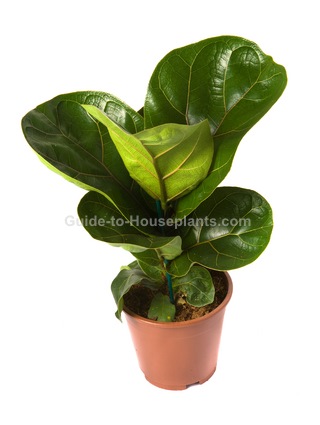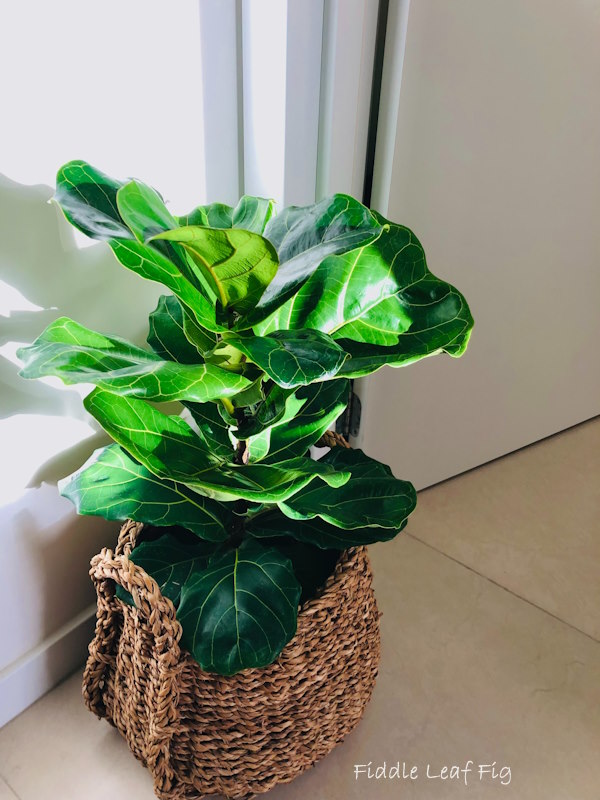Fiddle Leaf Fig
Fiddle Leaf Fig tree gets its name from its big, violin-shaped leaves. Known botanically as Ficus lyrata, it has become a decorator's dream, making a dramatic accent in any brightly lit room.
Find out how to grow this beautiful indoor ficus tree. Here you'll discover how much light it wants year-round, when to repot, and how to prevent leaf drop.

Get to Know Fiddle Leaf Fig
Its bold, prominently veined leaves grow to 12 in (30 cm) long and 6 in (15 cm) wide with wavy edges. Enormous leaves shaped like violins make Fiddle Leaf Fig a dramatic accent.
Those big leaves tend to be dust-catchers. Dust is not only unattractive, it prevents the leaves from getting the air and sunlight it needs to stay healthy. And don't use leaf-shine products because they can also interfere with photosynthesis. Keep the naturally glossy leaves clean by gently wiping them often with a damp cloth.
How Big Does Ficus Lyrata Get?
In its native habitat, this fig tree from the Moraceae family will grow about 40 ft (12 m) tall. Fortunately, Ficus lyrata grows very slowly and stays much shorter when grown indoors in a pot. You can expect your houseplant to reach 3-10 ft (90 cm - 3 m).
Want a smaller houseplant? A few dwarf fig tree cultivars are available, including 'Bambino' and 'Little Fiddle'.
Controlling its height is easy to do. Prune off the top of young plants to promote branching and to curb its height. You can also limit its size by keeping it in a small container.
You don't have to cut it back, though. The broad leaves of this fig tree make it a beautiful, live structural accent in a room with high ceilings.
Fiddle Leaf Fig Problems, Solutions and Answers
Wondering when to repot? Repot only when necessary (e.g., its roots are growing out of the drainage holes or coiled in the bottom of the pot) in spring, using the smallest pot that will contain its roots. Use a heavy container to keep it from toppling over; this tree can get top-heavy.
Brown leaf tips are sometimes caused by dry soil. Use a container with a drainage hole and water the plant thoroughly until water drains out the bottom. This is the only way to be sure that all the roots are watered.
Dropped Leaves?
If you just brought your plant home from the nursery and it dropped some of its leaves, don't worry. It's just adjusting to its new home. With good care, it'll grow new leaves.
Leaf drop is fairly common with ficus plants, especially when they're moved to a new environment. Changes in light levels and temperature can cause leaves to drop, so it's a good idea to put your plant in a bright spot, out of direct sunlight and leave it there. Also keep it away from heat/AC vents or drafts from entryways. It may take a few weeks for your plant to adjust to a new place, so don't give up on it.
While it may be tempting to repot, overwater or fertilize a shedding fig tree, don't do it. It'll only cause more stress to the tree and make the problem worse.
Something bugging your fig? A couple pests may invade figs trees. Scale are small brown insects that cling to stems and leaves, sucking sap and secreting a sticky residue on the plant. Also watch for webbing between branches and leaves, they're a tell-tale sign of a spider mite invasion. Treat any infestation immediately.
Is Fiddle Leaf Fig poisonous? Yes. Ficus lyrata is toxic to people, cats and dogs. It should not be eaten and its sap may cause skin irritation. It's a good idea to wear gloves when pruning and repotting this plant.
Although a bit fussy, fig plants make long-lived and beautiful indoor trees. Give your plant what it wants and you'll enjoy your Fiddle Leaf Fig for many years.
 Fiddle Leaf Fig makes a gorgeous houseplant. Photo by Sandra Martins
Fiddle Leaf Fig makes a gorgeous houseplant. Photo by Sandra MartinsFiddle Leaf Fig Care Tips
Origin: Western Africa
Light: Give Ficus lyrata bright indirect light year-round. Give your fiddle leaf fig a quarter turn every week or so to expose all sides to light. Like other ficus houseplants, its leaves will drop if suddenly moved into low light.
Water: Use a planter with drainage holes to avoid soggy soil, which can lead to root rot. Water thoroughly, then allow potting mix to dry out a bit before watering again. Drooping yellow leaves are a sign of overwatering.
Humidity: Average room (around 40-50% relative humidity). If indoor air is dry, the best way to increase humidity for your tropical houseplants is to use a cool-mist room humidifier.
Temperature: Average room temperatures 65-75°F/18-24°C suit this ficus just fine. Take care not to expose your fiddle leaf fig to drafts from windows and doorways. Remember, this fig doesn't like cold drafts and may protest by dropping its leaves.
Soil: Good-quality all-purpose houseplant potting mix with added perlite for faster drainage.
Fertilizer: Feed 3 times a year during the growing season (spring-summer-fall) with a balanced water-soluble fertilizer. Stop fertilizing in the winter months when growth is slow.
Propagation: Stem tip cuttings and air layering. Propagating large-leaf fig trees is not easy for the amateur to do at home. These trees are slow to root from either method.


